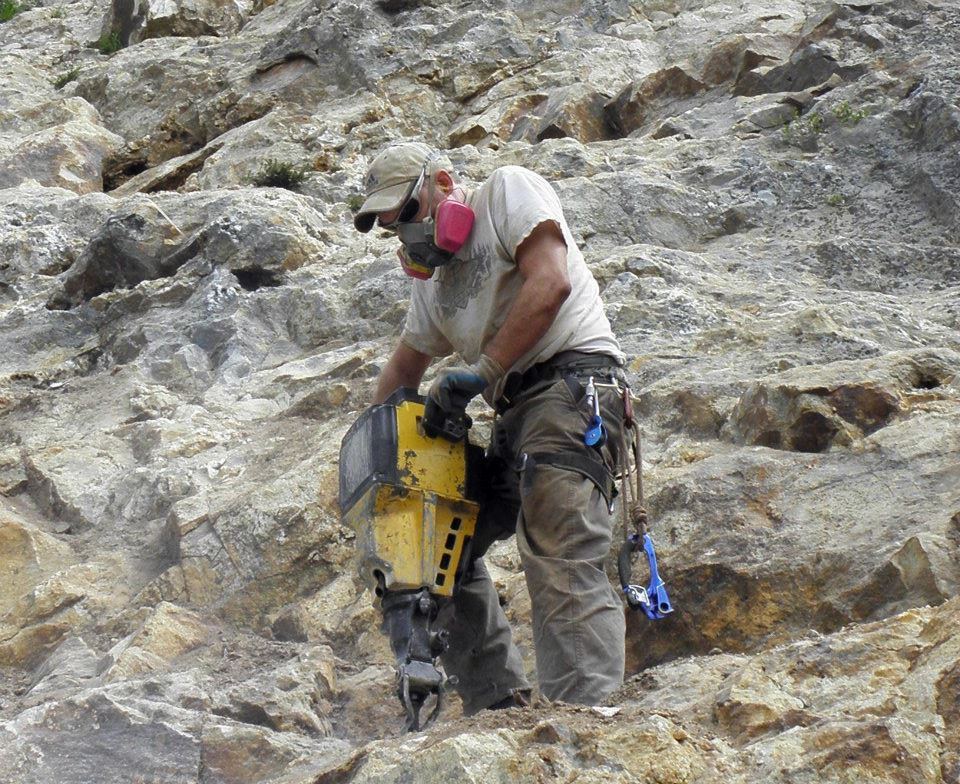Compressed air plant
Contents |
[edit] Introduction
There are a wide range of tools and plant on construction sites that use compressed air as their power source. The advantage that this equipment has is that the power source is very mobile and so they can be easily handled, which can be beneficial on isolated sites or in confined spaces.
The type of plant will depend on the nature of the work involved. The type of compressed air system can be either:
- Local: The compressor unit, with air-receiving tank, is mounted on a mobile unit for moving around the site.
- Centralised: A larger, semi-permanent compressor house is built to accommodate the plant and a network of air pipes taken to various outlet points.
[edit] Air compressors
The two main types of compressor are the reciprocating or piston type and the rotary impeller type.
[edit] Reciprocating compressor
This can be either single stage or multi-stage:
- Single stage: Air is drawn into the cylinder and a piston compresses it in one stroke.
- Multi-stage: Air passes through a series of cylinders, each of which contains air at increasing pressures.
Multi-stage compressors have the advantage of giving greater efficiency, and are suitable for high pressures and high volumes of air. This makes them useful for centralised plant, as the amount of compressed air can be as much as 130 m3 per minute.
[edit] Rotary compressor
These consist of a high-speed rotor mounted in a cylinder. Air is drawn in from an intake port by centrifugal force and exits through the delivery port when the required pressure has been achieved. Air receivers store the compressed air as it leaves the high pressure cylinder and minimise pressure fluctuations.
[edit] Tools and equipment
The four basic types of tools are:
[edit] Percussion type tools
- Concrete breakers (jack hammer): These are used for breaking up road surfaces. They consume air at a rate of 10-20 m3/min, and typically weigh 15-40 kg. They are flexible in terms of being able to be fitted with a variety of heads for different requirements.
- Pneumatic picks: Similar to concrete breakers but smaller and lighter. Typically they have an air consumption rate of around 6 m3/min.
- Backfill rammers: Used for backfilling trenches and have a consumption rate of around 10 m3/min.
- Chipping, caulking, riveting hammers: Small, lightweight tools with low air consumption of around 0.5 m3/min.
[edit] Pneumatic tools (with rotary action)
- Hammer drills: Used for wet or dry drilling, and commonly used for drilling rock or concrete. A rotary motion is generated by the piston, which produces the hammer action. Typically they have an air consumption rate of 5-10 m3/min.
- Rock drills: Larger and heavier than hammer drills, they are and commonly used for tunneling and quarry drilling. Their weight often necessitates the use of a frame support. They have an air consumption rate of around 15-24 m3/min.
[edit] Rotary type tools
These are powered by air motors with rotary sliding vanes. Common examples include; chainsaws, circular saws and wood-boring machines.
[edit] Miscellaneous tools
- Concrete vibrators.
- Concrete-placing and spraying equipment.
- Jacket-type silencers (these are often used as a means of dampening the noise created by compressed air equipment).
- Paint-spraying equipment.
- Pile-driving equipment.
- Road compactors.
- Sump pumps.
[edit] Related articles on Designing Buildings Wiki
- Bituminous mixing and laying plant.
- Breaker.
- BSRIA Compressor Study September 2020 - The Americas and China
- Cherry pickers.
- Concreting plant.
- Construction plant.
- Construction tools.
- Crane supports.
- Earth-moving plant.
- Equipment in buildings.
- EMEA compressor market 2020 - 2023.
- Excavating plant.
- Forklift truck.
- Hand-arm vibration syndrome.
- Hoist.
- Lift table.
- Pallet jack.
- Power float.
- Pumps and dewatering equipment.
- Road sweeper.
- Scabbler.
- Scaffolding.
- Six remarkable benefits of high pressure water jetting.
- Types of crane.
[edit] External references
- ‘Introduction to Civil Engineering Construction’ (3rd ed.), HOLMES, R., The College of Estate Management, (1995)
Featured articles and news
Independent Building Control review panel
Five members of the newly established, Grenfell Tower Inquiry recommended, panel appointed.
ECA progress on Welsh Recharging Electrical Skills Charter
Working hard to make progress on the ‘asks’ of the Recharging Electrical Skills Charter at the Senedd in Wales.
A brief history from 1890s to 2020s.
CIOB and CORBON combine forces
To elevate professional standards in Nigeria’s construction industry.
Amendment to the GB Energy Bill welcomed by ECA
Move prevents nationally-owned energy company from investing in solar panels produced by modern slavery.
Gregor Harvie argues that AI is state-sanctioned theft of IP.
Heat pumps, vehicle chargers and heating appliances must be sold with smart functionality.
Experimental AI housing target help for councils
Experimental AI could help councils meet housing targets by digitising records.
New-style degrees set for reformed ARB accreditation
Following the ARB Tomorrow's Architects competency outcomes for Architects.
BSRIA Occupant Wellbeing survey BOW
Occupant satisfaction and wellbeing tool inc. physical environment, indoor facilities, functionality and accessibility.
Preserving, waterproofing and decorating buildings.
Many resources for visitors aswell as new features for members.
Using technology to empower communities
The Community data platform; capturing the DNA of a place and fostering participation, for better design.
Heat pump and wind turbine sound calculations for PDRs
MCS publish updated sound calculation standards for permitted development installations.
Homes England creates largest housing-led site in the North
Successful, 34 hectare land acquisition with the residential allocation now completed.
Scottish apprenticeship training proposals
General support although better accountability and transparency is sought.
The history of building regulations
A story of belated action in response to crisis.
Moisture, fire safety and emerging trends in living walls
How wet is your wall?
Current policy explained and newly published consultation by the UK and Welsh Governments.
British architecture 1919–39. Book review.
Conservation of listed prefabs in Moseley.
Energy industry calls for urgent reform.































